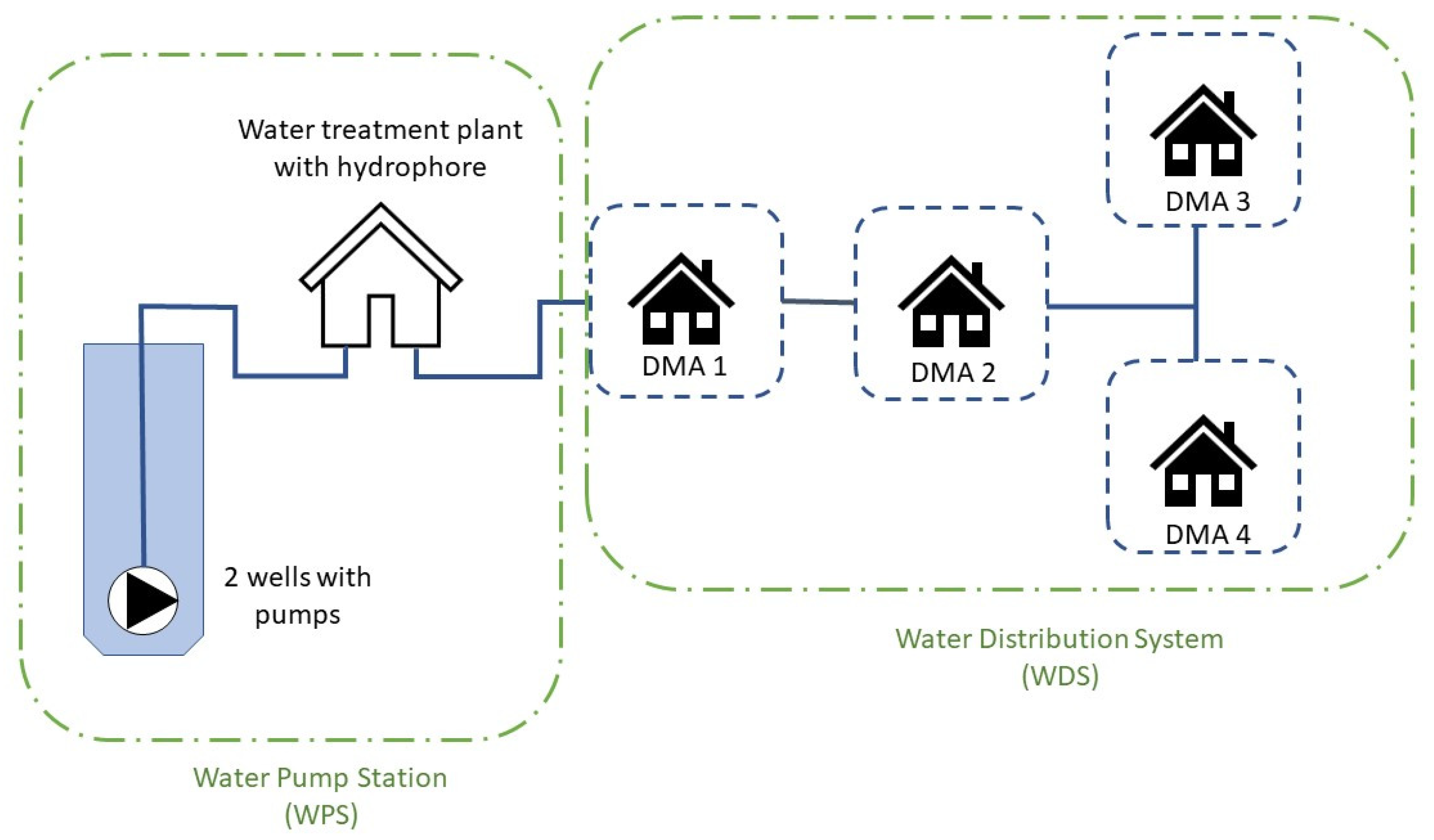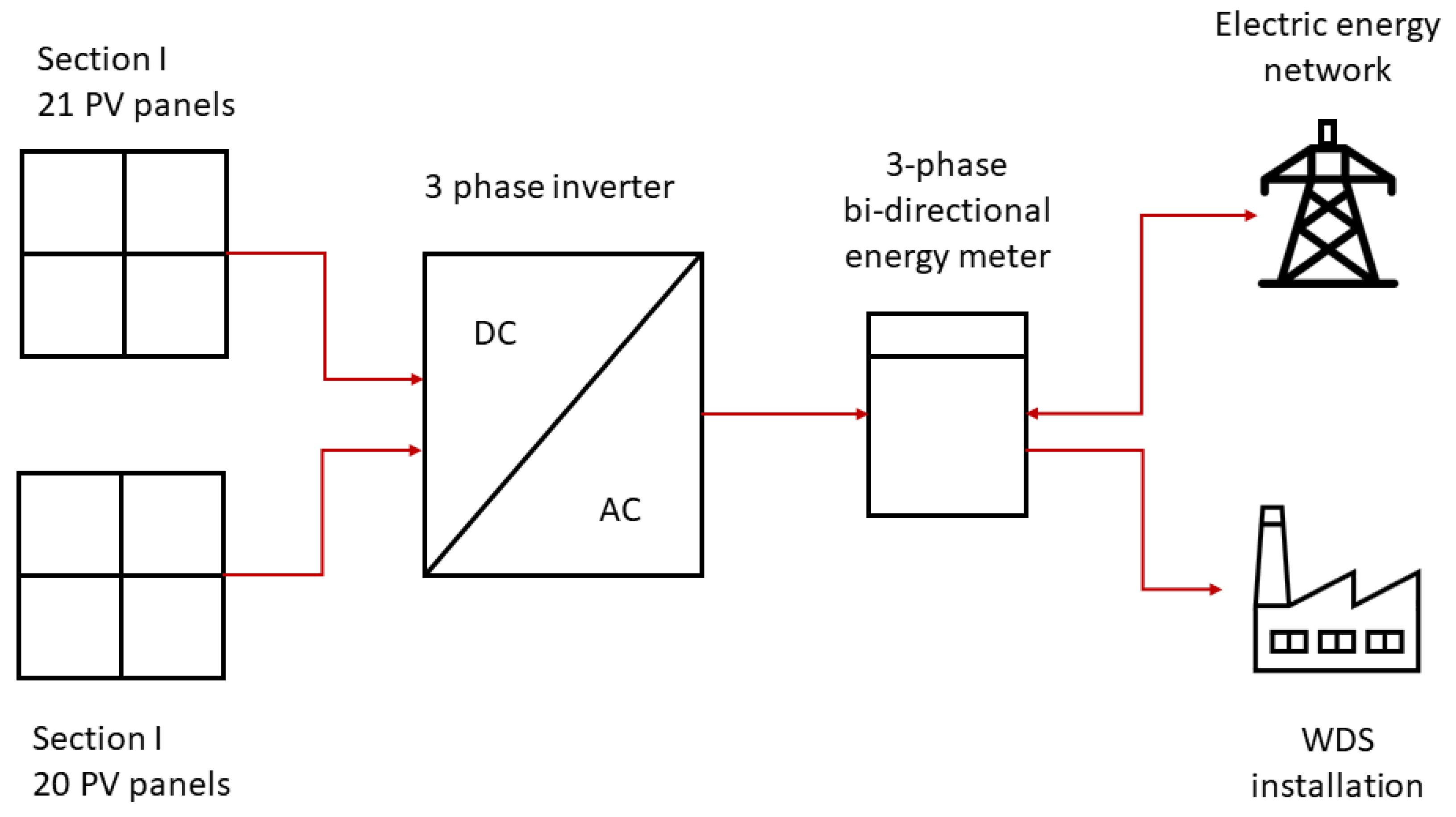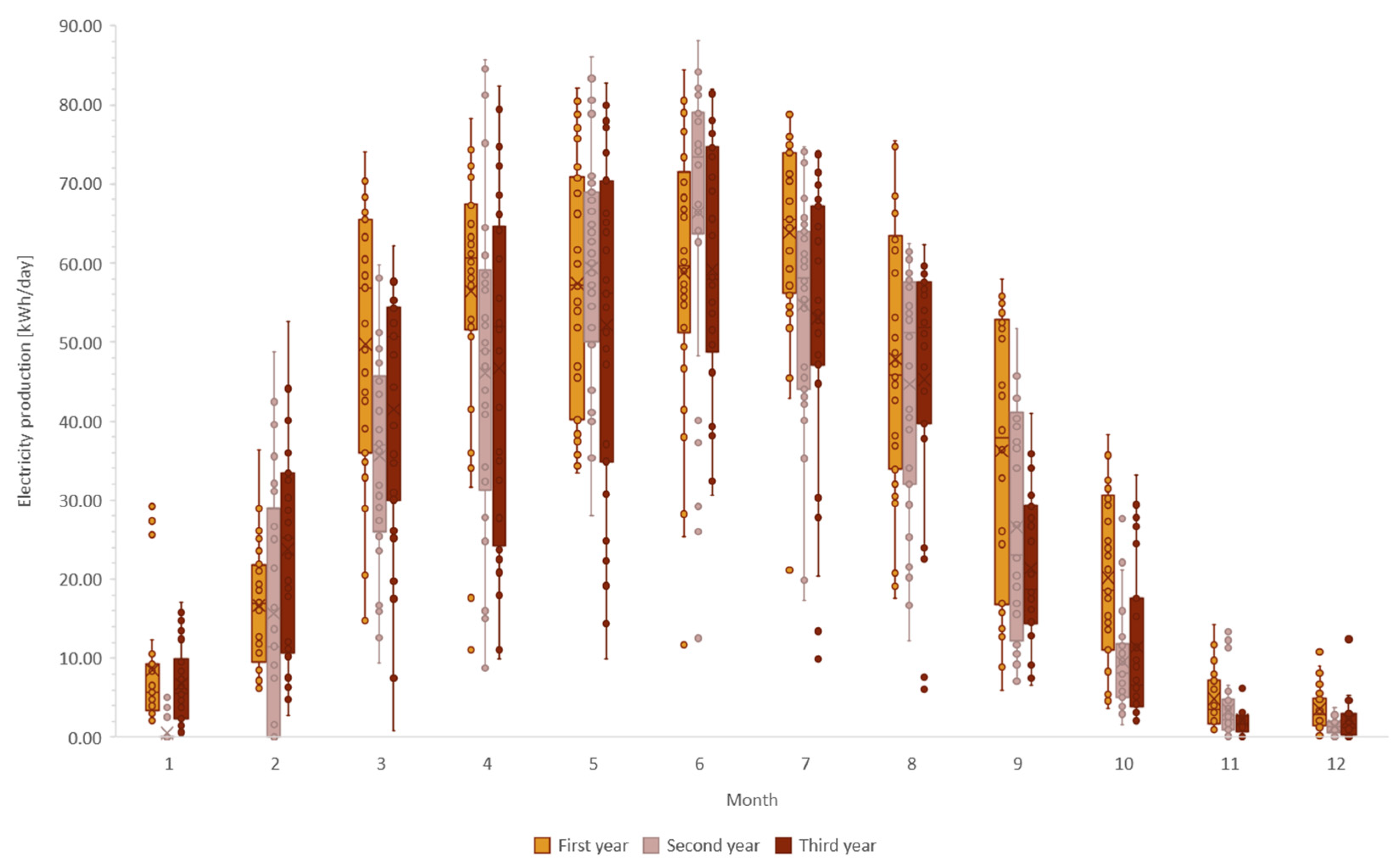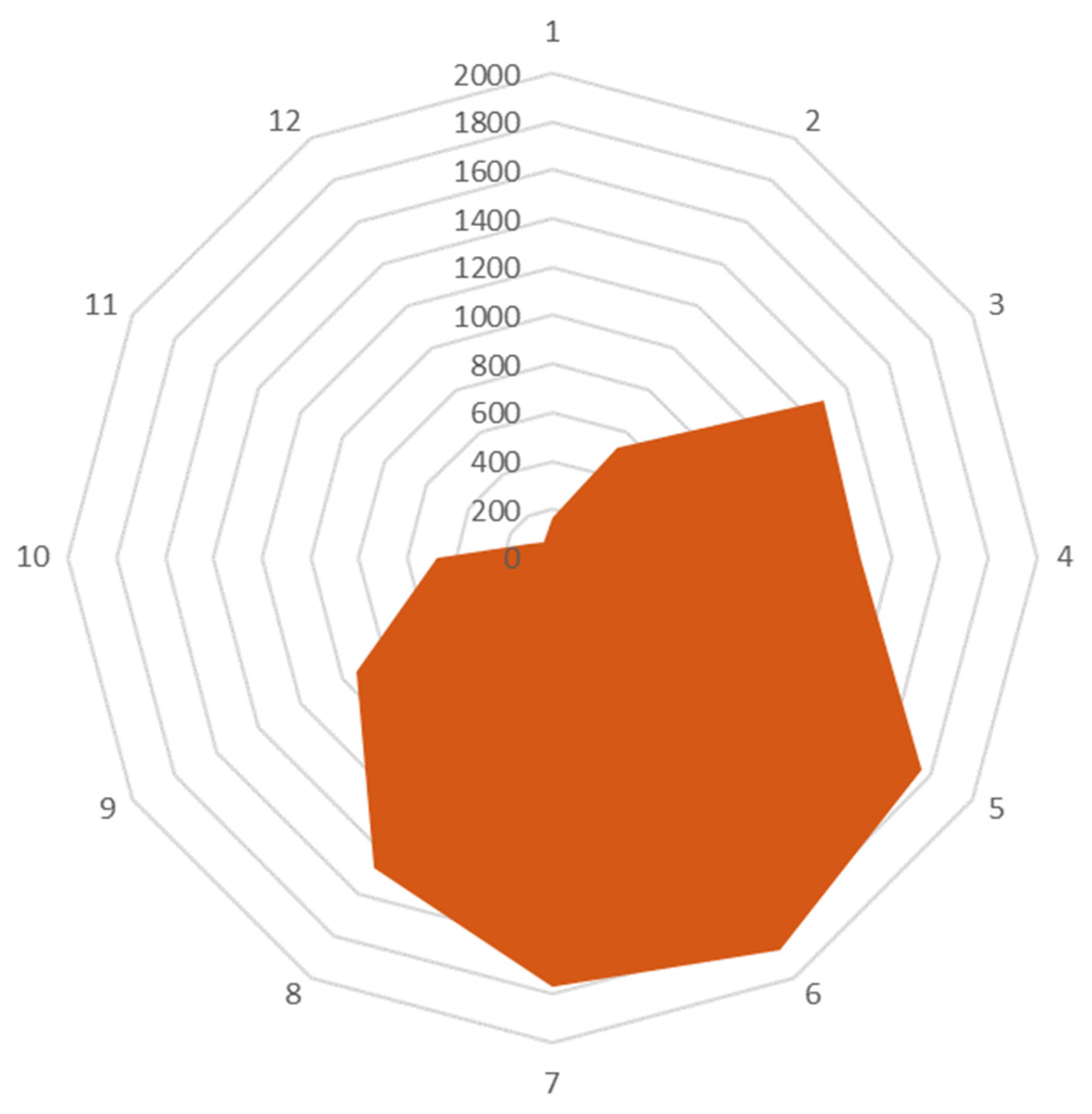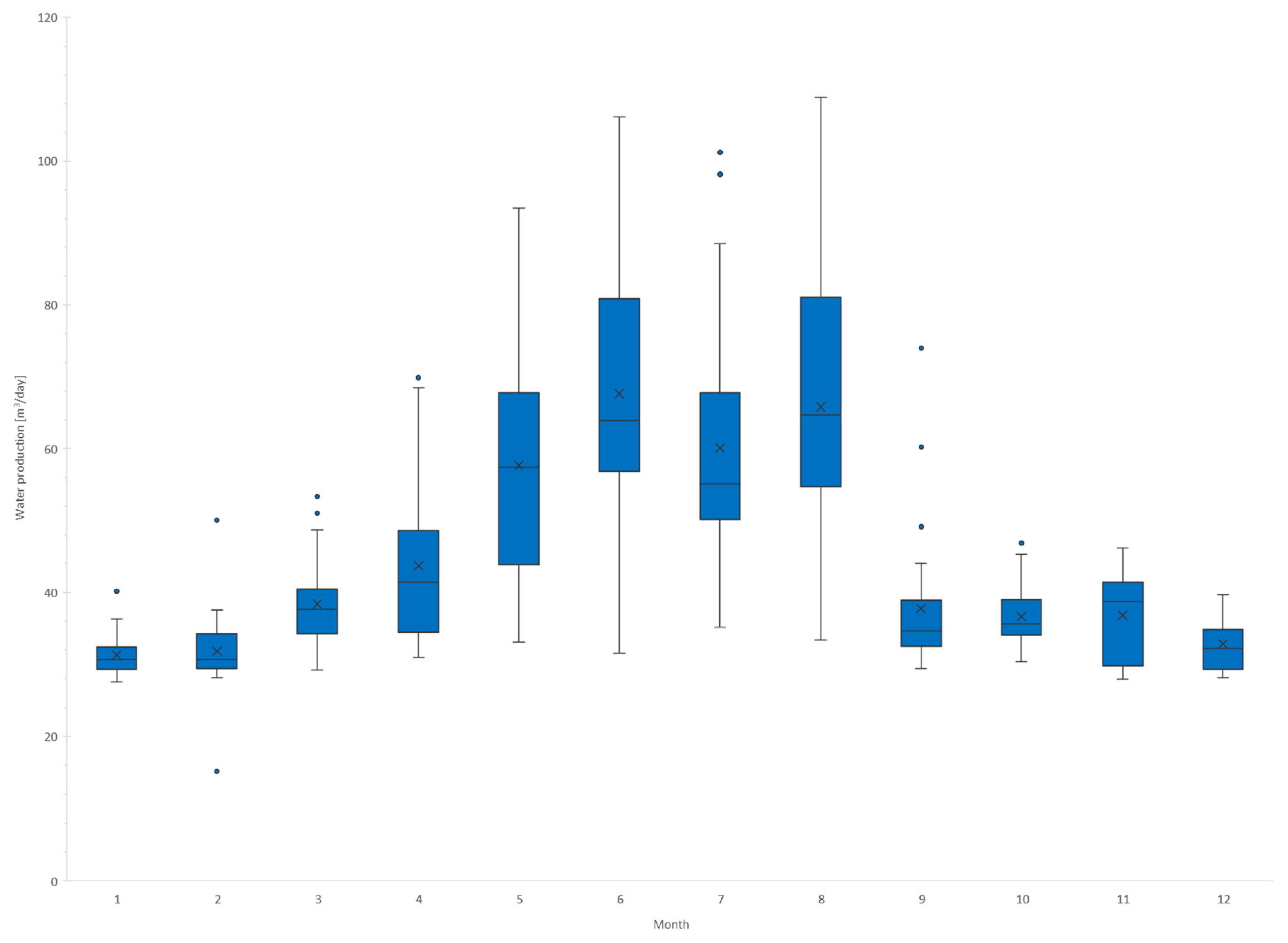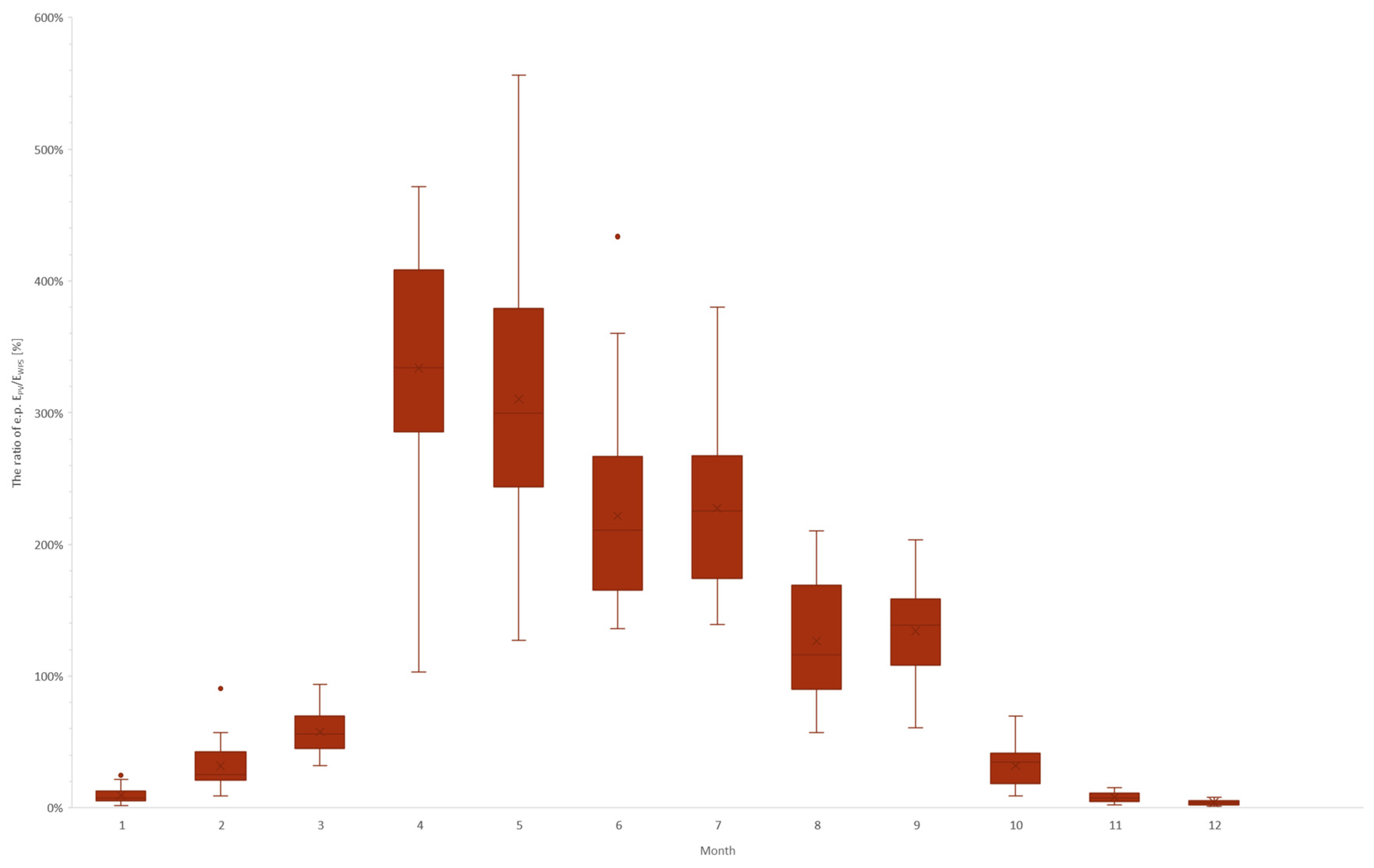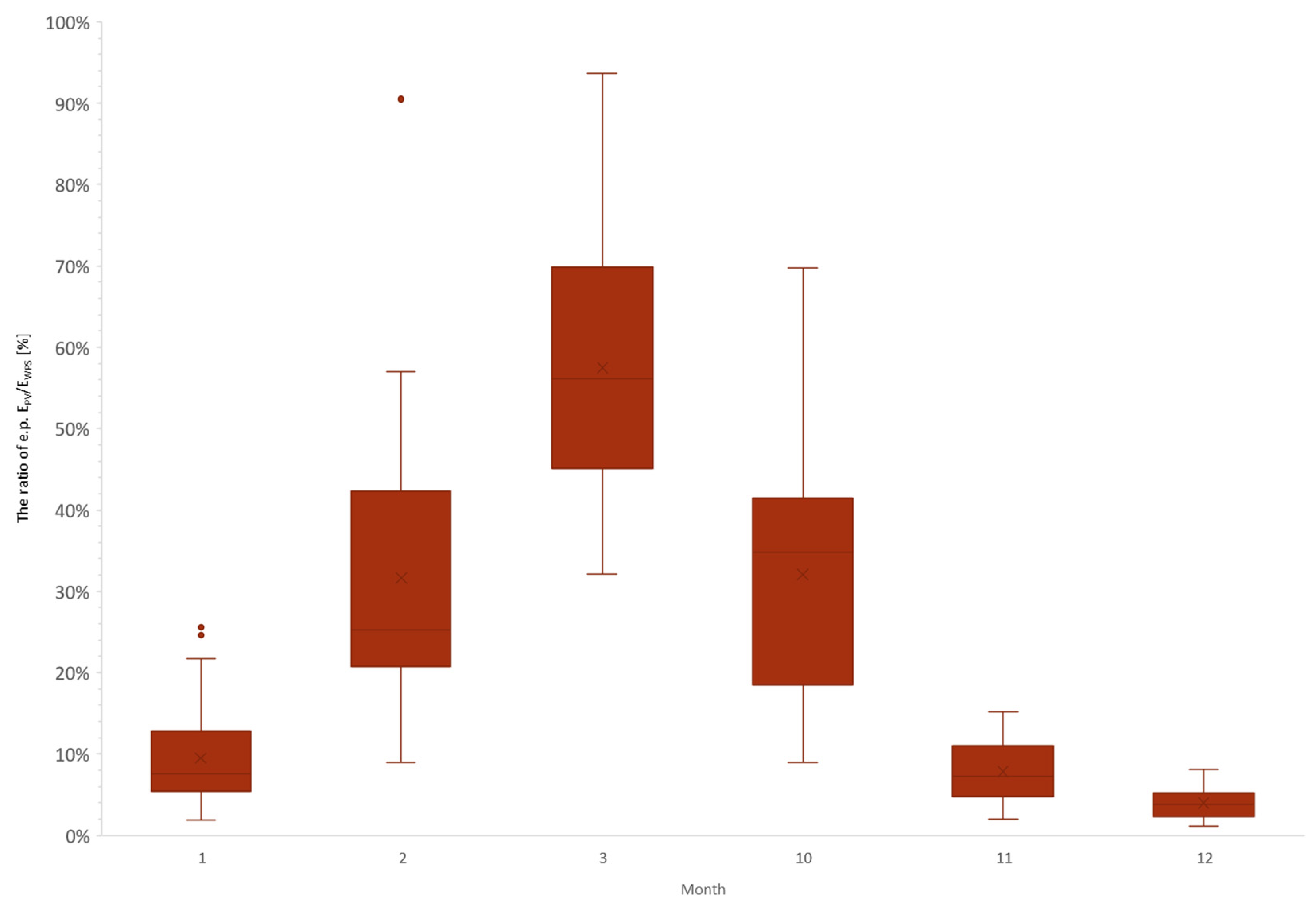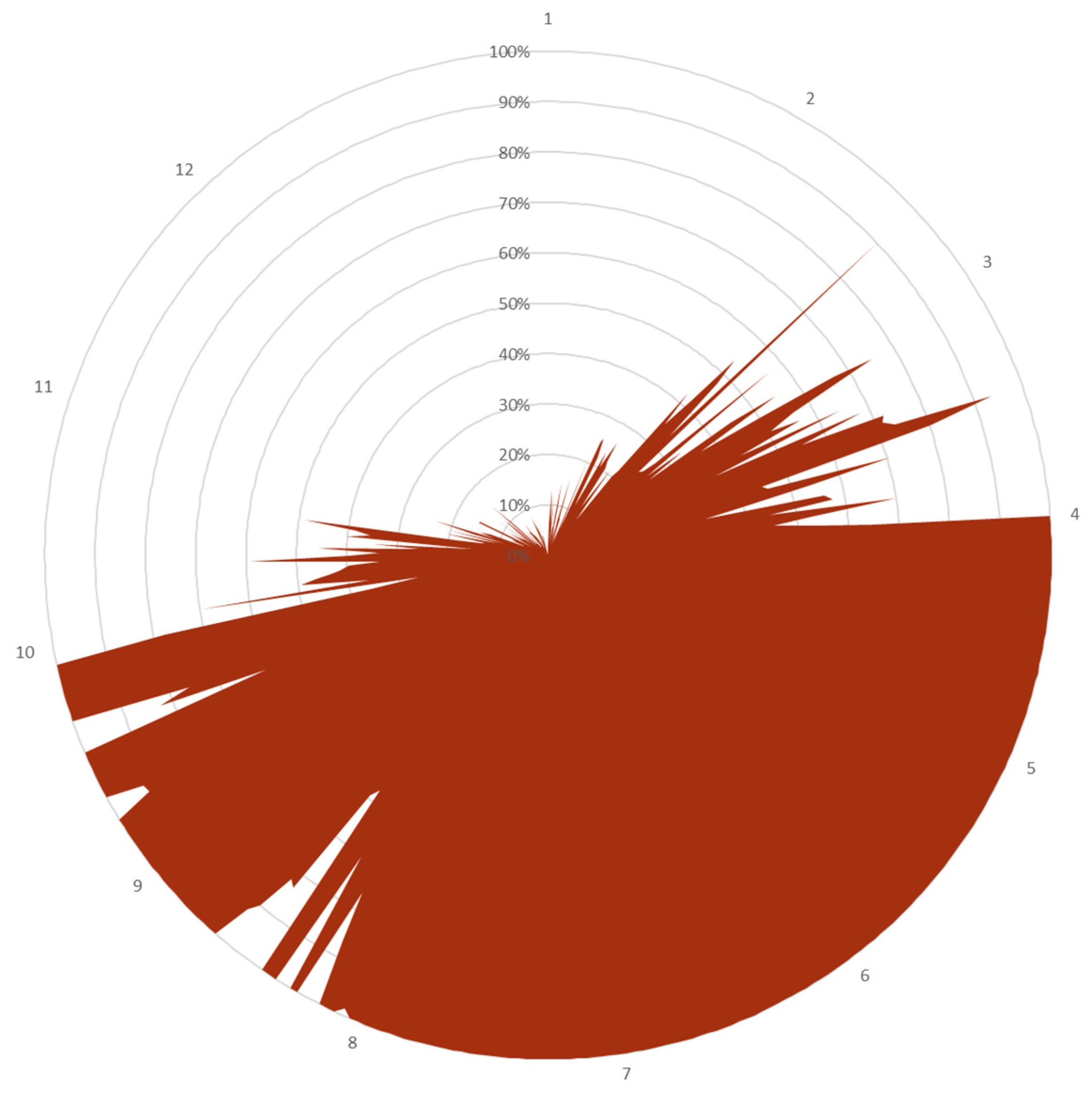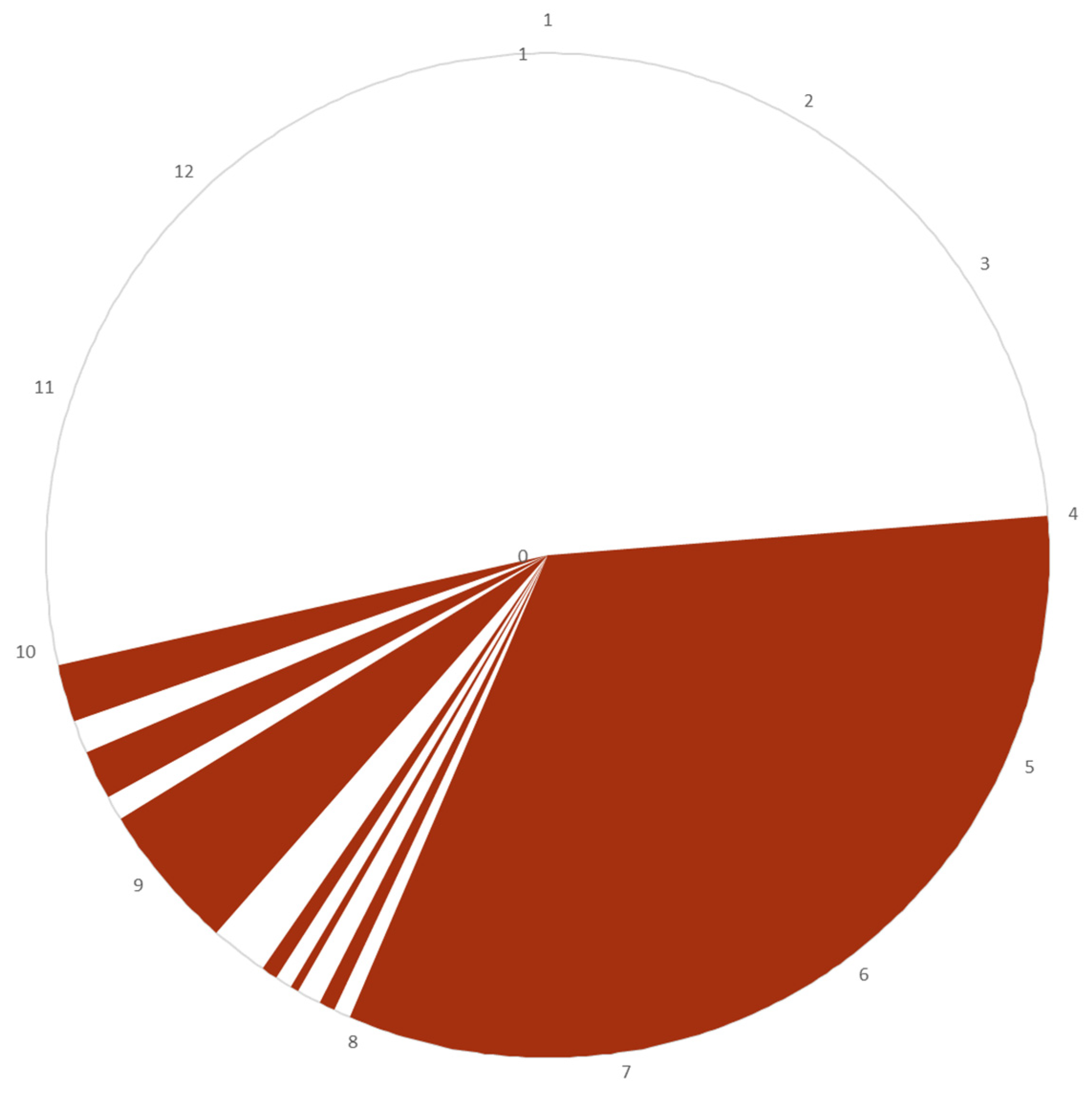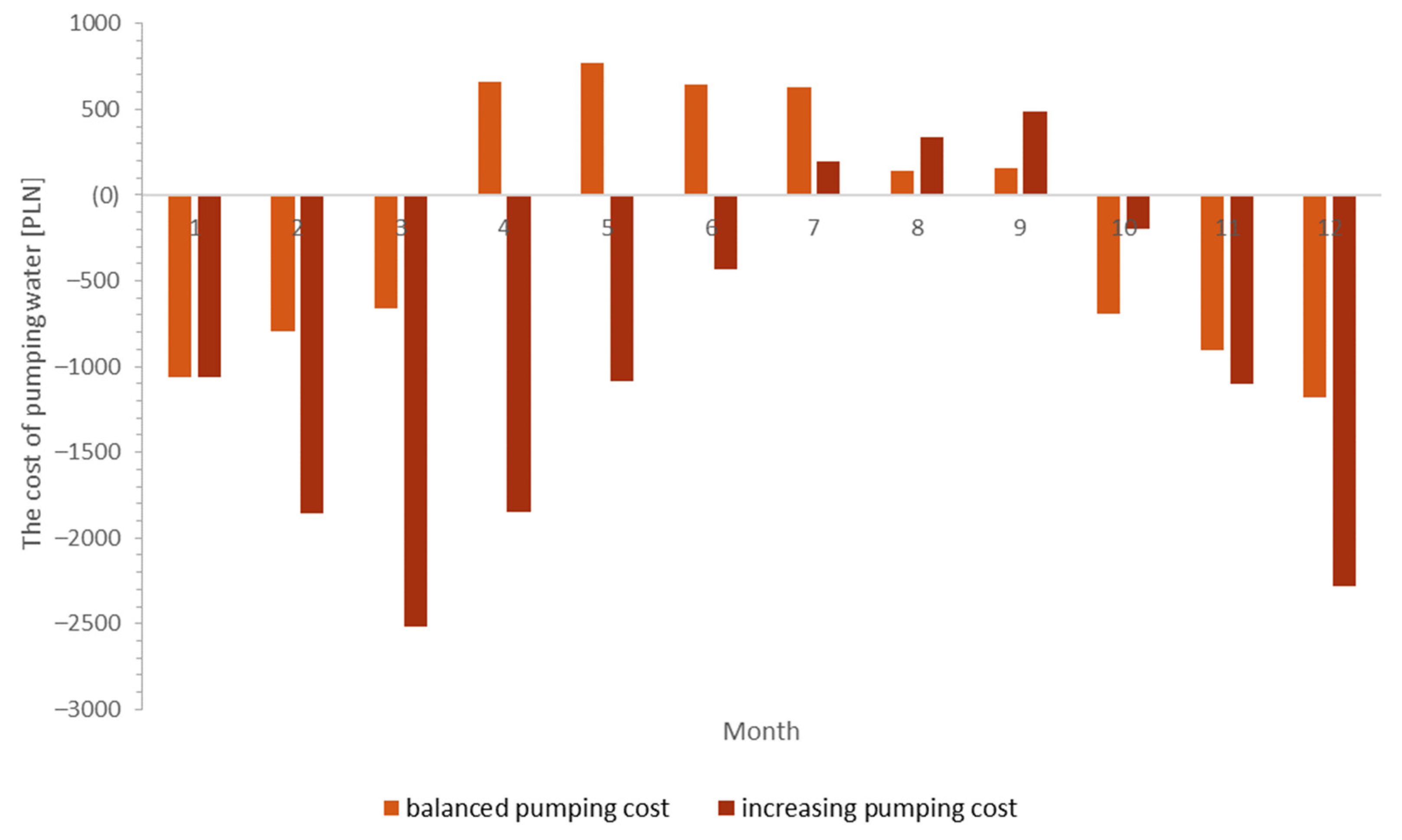1. Introduction
Energy crises, increasing carbon dioxide emissions, rising fossil fuel prices, and water shortages constantly pose new requirements and challenges for global economic development, including water supply and wastewater collection [
1]. Plumbing systems use large amounts of electricity. Electricity is necessary for technological processes related to water intake (deep wells equipped with pumps, pumps for pumping water from the source to the Water Treatment Plant), its treatment (pumps, aerators, etc.), and transport (secondary pumping stations and local pumping stations) [
2,
3]. The production of clean water (product) requires the implementation of processes (water intake, water treatment) and the organization of the entire water supply system in a sustainable, effective, and economical manner while respecting the natural environment [
4]. Energy costs account for approximately 65% of the operating costs of water supply companies [
5]. One way to introduce changes is to reduce electricity consumption. First, one should strive to improve the energy efficiency of devices forming the water supply system. The second way to reduce electricity consumption by the water supply system is to ensure the supply of energy from renewable energy sources. Reducing electricity consumption must not adversely affect the provision of optimal pressure at consumers and the appropriate amount of water required by law [
6]. Supplying the right amount of water under the correct pressure requires water-pumping stations. Water-pumping stations consume the most electricity in transporting water from the intake to the water consumer [
7]. That is why it is essential to improve the energy efficiency of water-pumping stations to reduce the company’s electricity consumption [
8]. Researchers are researching optimizing the operation of pumps and regulating their speed [
9], the possibility of rebuilding the pipe system [
10] (including increasing the diameter of the pipes to reduce pressure losses [
11]) or replacing them—reducing roughness in old pipes [
12]), modifying the control algorithms [
13], or finding new network elements that can generate electricity, e.g., microturbines [
14,
15]. Schedules are developed based on water consumption in a given settlement unit supplied by a pumping station based on flow values recorded on a flow meter or water meter [
16,
17]. The schedules can distinguish periods of reduced water consumption (night time) and increased water consumption (morning and evening hours), as well as the variability of water consumption characteristics on working days about weekends and holidays [
18,
19,
20]. Numerous studies are underway on the use of Simple Genetic Algorithms (SGA), Hybrid Genetic Algorithms (HGA), and Artificial Neural Networks (ANN) [
21]. Optimization processes are complicated, but they can provide measurable benefits in reducing electricity consumption, reducing CO
2 production, and ensuring the efficiency of the water supply [
22,
23].
In 2021, 92.24% of electricity produced in Poland came from the combustion of fossil fuels—coal, oil, and gas [
24]. The burning of fossil fuels contributes to increased CO
2 emissions. An alternative is using renewable energy sources, e.g., solar energy through photovoltaic cells and wind energy from wind farms. Only 7.76% was produced from renewable energy sources—0.84% came from solar energy [
24]. Using solar panels as a power supply from the grid (derived from the combustion of coal or other minerals), with a properly selected technological solution, can reduce carbon dioxide production [
25].
PV installations are often used when pumping stations generate high labor costs to supply water to all consumers (remote location of customers about the pumping station, terrain elevation, high demand) [
26].
The problem with using solar panels is the dependence on appropriate environmental conditions: cloudy days reduce production, reduced production in autumn and winter, and location (in northern Europe, on average, about 50 W/m
2 can be obtained annually) [
27]. In the case of pumping stations in rural areas or with high instability of electricity production from panels, solutions can be sought in PV+BESS systems [
28]. PV installations are also subject to optimization, e.g., numerical methods to obtain the highest efficiency of energy acquisition [
29]. PV installations are most often the first choice of owners of water-pumping stations to reduce the costs of purchasing electricity [
30]. When developing a PV installation–water pump station system, knowledge and experience, as well as components and parts related to various engineering disciplines, such as mechanics, electricity, electronics, computers, control, and sanitary engineering, should be combined [
31].
The optimization of the pump operation, selection of new sets, and change of technology “water well–water treatment–tank–pumping water to the network” requires great skills and services of people who will perform the work, and its result may be economically unbearable for the water supply company [
32,
33]. Investments are sought that enable the so-called quick win. After analyzing the literature, we found that it would be useful to carry out research and analyze how the production of electricity from PV installations can reduce water-pumping costs. The choice of the PV installation is treated as a quick win, but it is not made on the basis of data and analysis. As the authors of the study, we found that we can fill this gap by showing the way to a deeper reflection on the investment process and optimization and reduction in costs when pumping water in single-stage systems. In Poland, the choice of PV installations is still met with a negative response of cheap investments not paying off in the Polish climate [
34,
35]. In the literature, the results of tests from areas with high insolation, mainly the Mediterranean basin, are most often performed.
The aim of the research is to check the possibility of reducing the cost of pumping water in WDS by installing a typical 12.3 kW photovoltaic installation for small industrial facilities. The tests are planned to be carried out at the existing pump station and the existing PV installation. The data recorded daily will be subject to the analysis of electricity production and consumption with the last flows during the year.
2. Materials and Methods
The research was carried out on the Water Pump Station and on a 12.3 kW photovoltaic installation. The measurement data concerning water flow, electricity consumption by pumping stations and production of electricity from PV installations were recorded.
The data were subjected to a monthly analysis of electricity production and consumption based on daily measurements of electricity production and consumption by the pump station. Data on the distribution of water pumping and the daily amount of water pumped into the network were used in the analyses, and the average electricity demand for pumping water was calculated for each month.
The measurement data and the analysis of the results of the measurement data of electricity and the amount of water were used to calculate the costs of the water-pumping station, cover the consumption of electricity by its production from PV installations, and to present them in the form of balanced pumping cost and increasing pumping cost.
2.1. Water Supply and Water Pump Station
The Water Pump Station (WPS) supplies the Water Distribution System (WDS) in rural and tourist areas. WPS has only a first-degree pump system (
Figure 1). WPS does not have a second-degree pumping station. Water from deep wells is pumped to treatment devices such as filters and aeration. The pressure in the distribution network at the exit from the WPS is maintained at the level of 0.22–0.48 MPa. Hydrophore tanks are responsible for maintaining the pressure.
The Water Distribution System consists of steel and cast iron pipes from the 1970s and plastic (mainly PVC) built in the 21st century. The WDS can be divided into four main residential areas, marked in
Figure 1 as DMA.
Measurements of flow changes were carried out with the use of MacR6 N by Plum Ltd (Ignatki, Poland). The flow was recorded using a water meter on the outgoing pipe in the WPS with a connected telemetric recorder. Data were recorded every 15 min. throughout the year. WPS electricity consumption data was taken from the energy meter records at the end of each month.
2.2. Photovoltaic Installation (PV)
The photovoltaic (PV) installation consists of 41 modules with a power of 300 Wp/10 kW, which gives a total power of 12.6 kW. The modules are grouped into two sections (
Figure 2). The full capacity of the existing generation units is 12.3 kW. The generating module consists of 60 monocrystalline cells. A three-phase inverter is responsible for the operation of the installation.
The value of electricity production was recorded from the moment of installation. Data from the period September 2019–September 2022 was used for the research. The daily electricity production data from the PV installation was stored in the inverter.
3. Results
The results of the conducted research have been divided into two sections: the results of the tests of the existing photovoltaic installation and the results of water production (the amount of water pumped by the WPS) and the costs of pump operation in relation to 1 m3 of water.
3.1. PV Installation—Electricity Production
The recorded values of the daily electricity production from the PV installation are shown in
Figure 3. The daily output varied during the year from 0.00 to 88.11 kWh.
In the first year of research, the PV installation produced 12.95 MWh. The average daily production of electricity was 35.39 kWh∙day−1. From March to August, the total monthly output of electricity exceeded 10% of the annual show. The most energy was produced in July, 1.98 MWh. The maximum daily electricity output was 84.36 kWh∙day−1 in June. The minimum daily energy production was 0.16 kWh∙day−1 in December.
In the second year of research, the PV installation produced 11.11 MWh. The average daily production of electricity was 30.43 kWh∙day−1. From April to August, the total monthly output of electricity exceeded 10% of the annual show. The most energy was produced in June, 1.99 MWh. The maximum daily electricity output was 88.11 kWh∙day−1 and took place in June. The minimum daily energy production was 0.00 kWh∙day−1 in December.
In the third year of research, the PV installation produced 11.13 MWh. The average daily production of electricity was 31.36 kWh∙day−1. In March and from May to August, the total monthly output of electricity exceeded 10% of the annual show. The most energy was produced in June, 1.87 MWh. The maximum daily electricity output was 82.82 kWh∙day−1 in June. The minimum daily energy production was 0.01 kWh/day in December.
The values of Q1 in each surveyed year from May to August were higher than the average daily electricity production from 3 years. The importance of Q2 in each year from March to August was higher than the average daily electricity production for three years. The values of Q3 in each year from March to September were higher than the average daily electricity production for three years. The importance of Q3 in each of the examined years in May and June was more elevated than twice the value of the average daily electricity production from 3 years.
The analyzed PV installation produced an annual average of 11.7 kWh. The average values of electricity production are presented in
Figure 4. The highest value of electricity production is in June. The least amount of electricity was produced in December. From May to July, the installation produced over 1.7 kWh per month (46.1% of annual production). From March to August, the facility produced around 1.0 kWh per month (80.5% of the annual output). From February to September, the installation produced about 0.5 kWh per month (90.3% of the annual production). The facility had only 7% of all energy from October to January. For further analyses, the average values from the study period were taken.
3.2. Water Production
Figure 5 presents the collected data on daily water production in the third year of experiments. WSP pumped from 15.8 to 108.8 m
3∙day
−1 into the water supply network. The average daily value of water production was 45.1 m
3∙day
-. From May to August, the total monthly production was over 10.0% of the annual output. The highest show was in June and August (12.3% and 12.4% of the yearly output. The lowest water production occurred in February and accounted for 5.4% of the yearly output.
Figure 5 clearly shows the tourist character of the town and the variability of water consumption by residents related to the summer nature of rest and the increase in the population in the area to which the WPS supplies water.
The average electricity demand for pumping water [kW∙(m
3)
−1] is presented in
Table 1. The WPS’s historical electricity consumption values allowed us to calculate the value of the average electricity consumption for pumping 1 m
3 of treated water into the water supply system. In February and March, electricity consumption per 1 m
3 of water was the highest and amounted to 1.92 kW∙(m
3)
−1. In March and May, electricity consumption per 1 m
3 of water was the lowest and amounted to 0.34 kW∙(m
3)
−1. From April to September, pumping 1 m
3 of water required less than 1 kW of energy.
4. Discussion
The authors calculated the daily demand for SRW electricity based on the collected data. The market was estimated using Formula (1).
EWPS—daily electricity demand for pumping water [kWh·day−1],
PD—daily water production (injected into the network) [m3·day−1],
DEMn—average electricity demand for pumping water [kW·(m3)−1] in n-month.
B—the value of covering the daily demand of WPS for electricity by the production of electricity from PV [%],
EPV—daily production of electricity by the PV installation [kWh·day−1],
EWPS—daily electricity demand for pumping water [kWh·day−1],
In the next step, the average daily electricity production from the PV (EPV) installation was compared with the daily electricity demand of WDS (EWPS). The value of covering the daily need of WPS for electricity by producing electricity from PV was calculated using Formula (2). The obtained values are presented in
Figure 6.
Period I—100% coverage of WPS’s demand for electricity from April to July;
Period II—an intermediate period in which most of the production of electricity from PV covers the demand of WPS–from August to September;
Period III—the period of lack of 100% coverage of WPS’s demand for electricity from October to March.
In period I, the value of B did not fall below 100% and reached the maximum value of 556% in May. Q1 values were higher in April and May than Q2 values in June and July. In April, Q1 was more elevated than Q3 in June and July.
In period II, the value of B varied between 57% and 210%. In June, for 75% of the days, the production of electricity from PV covered 100% of WPS’s demand. In August, for over 50% of the days, the production of electricity from PV covered 100% of WPS’s market. Q3 was 159% in September and 169% in August.
Figure 7 compares the average daily electricity production from PV (EPV) installations with the daily WDS electricity demand (EWPS) from January to March and from October to December. These are periods in which the electricity production from the PV installation did not cover the daily electricity demand of the WPS. The minimum coverage of the daily market was 1% (in December), and the maximum coverage was 94% in March. February and October are similar: average daily coverage was 32%, Q
1 = 21% in February and Q
1 = 19% in October, Q
2 = 42% in February, and Q
3 = 41% in October. In March, PV production provided an average of 57% of WPS’s demand (Q
2 = 56%), Q
1 = 45%, and Q
3 = 70%. The worst results were achieved in December. Where the maximum production amounted to 8% of the WPD demand, the average production value covered 4% of the WPS demand.
Figure 8 shows the days where the value of B is between 0 and 100%. B ≤ 100% was achieved 198 days a year. For 114 days, the PV installation covers less than 25% of the E
WPS. For 154 days, the PV installation covers less than 50% of the E
WPS. For 182 days, the PV installation covers less than 75% of the E
WPS.
Figure 9 shows days where B is more significant than 100%. B > 100% was achieved 167 days a year (45.8% of the days of the year).
It was assumed that negative values on the
y-axis mean the need to collect electricity from the power grid, payment for the energy consumed, and positive values on the
y-axis mean the overproduction of energy from the PV installation about the energy consumption by WPS and the sale of energy to the power grid. An energy unit’s average purchase and sale price was assumed to be PLN 0.67, excluding VAT per 1 kWh. For each month, the energy purchase cost was balanced with the value of energy production and is presented in
Figure 10. From April to September, the balance of production and consumption costs is positive, which means it is possible to sell the surplus of energy produced. From October to March, the total value of electricity production is lower than the total cost of energy consumption by WPS, which means that it is necessary to purchase energy from the power grid.
Figure 10 shows the increasing energy purchase cost by the energy production value. In July, the deal of energy sold covers the purchase costs calculated from the beginning of the year. The state of higher energy sales than its purchase lasts until September. Since September, the value of energy produced is again lower than the value of fuel purchased for the needs of WPS
The total cost of pumping water by WPS is PLN 10,251.28 per year. The total value of electricity production from PV is PLN 7967.58 per year. The balanced cost of pumping water is PLN 2283.71 per year. A PV installation can cover approx—77.8% of WPS’s demand for electricity.
The presented research and discussion results show that the installation of a PV installation in Polish climatic conditions for the analyzed WPS will not fully cover the pumping costs. Month to month. The worst results fall in autumn and winter, which is confirmed by other works of literature [
26,
27]. Total pumping costs are also higher than the energy produced. The use of only a PV installation without optimizing the drive technology will make it possible to change the method of the pumping station (fixed speed pumps to variable speed pumps, a two-stage pumping system, optimization of control algorithms) and it will not be possible to meet the energy needs exclusively from the PV installation. Another aspect is the issue of the size of the installation and the provision of energy storage facilities (PV+BES installation [
28]), which will allow for the storage of excess energy produced during the period of reduced production. Choosing a PV installation as the first choice to reduce costs [
30] is not entirely bad as it reduces pumping costs, but by using other methods you can make the optimal choice of PV installation size As it results from the collected literature, the field for research in this aspect is wide and important for the economy.
5. Conclusions
As an element of the economy, water supply companies provide an essential product: water. This requires the organization of the entire process of producing and supplying water to consumers. Achieving sustainable development in production requires a holistic view covering the product and production processes related to its production and the entire supply chain, including production systems in many product life cycles. This requires improved models, sustainability assessment metrics, and optimization techniques at the product, process, and system levels.
The search for ways to reduce the energy consumption of water intake and delivery to consumers encourages using renewable energy sources, such as PV panels. The studies showed the possibility of lowering the costs of pumping water to the water supply network by over 77%. Lowering the cost of pumping allows you to reduce the price of 1 m3 of water purchased by the recipient. The 12.3 kW PV installation can provide 100% of electricity for the tested water-pumping station for 167 days a year.
When choosing the size of the PV installation, attention should be paid to the size of the installation and the possibility of making the water-pumping station independent of the purchase of electricity from the grid. However, this requires conducting simulation studies on the options of selecting the optimal size of the PV installation for the needs of a given facility.
The analysis of the literature and the research described in this article show that research on other types of water supply facilities and the possibilities of their power supply from RES could be undertaken, as well as the challenge of research and solutions to make the work of key facilities such as pumps independent of the power supply from the electrical power grid. This requires detailed research and the introduction of more detailed measurements.
